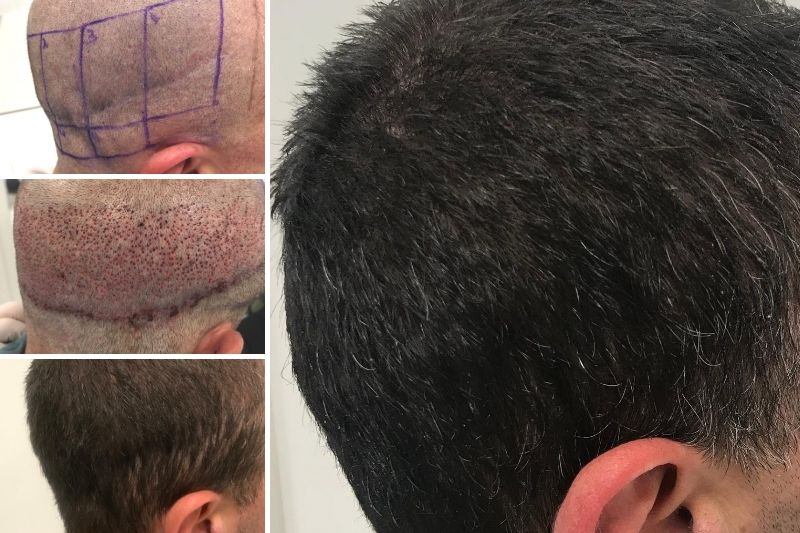Up to 70% of our patients come to us for help after receiving a botched hair transplant elsewhere and suffering obvious scarring or other disappointing outcomes. Hair may have been implanted in the wrong direction, angle, or position by an unscrupulous or ill-trained clinic.
Some come to see us because they have strip scars from FUT strip surgery or even FUE (follicular unit extraction) scarring where there was not enough hair density for success, leaving the patient with noticeable scarring both in the recipient and donor area.
Fortunately, advancements in hair transplant surgery has allowed us to correct dreadful hair restoration results, scarring from FUT hair transplants, and other complications of previous surgeries. Our purpose at Paras Hair Transplant is to provide the best possible outcome from the beginning, to avoid unnecessary future corrections down the track.
Dr Paras has developed an advanced method of FUE to repair the dreaded “strip scar,” one of the most common complications of FUT strip surgery.
Visible scarring is a potential complication of hair transplants
One of the most significant complications that should be discussed at an initial consultation for FUT hair transplant surgery is the possibility of developing a strip scar. During FUT strip surgery a strip of scalp is removed from the back of the head and then sutured up. Patients must be fully informed and understand the long-term effects of proceeding with the FUT strip procedure as part of the all-important consent process: most likely they will have a permanent scar in the back of their scalp as a result of this procedure.
In the past, before we had FUE, FUT was the only procedure available. Patients were told that the only way to remove hair for a hair transplant, was to take a strip of scalp tissue containing hair follicles/grafts and then dividing the hair under a microscope, by individually cutting each follicle/graft and preparing them for implantation.
FUE was developed over several years during the mid-1990s to mid-2000s. Early on, doctors did not favour this procedure. It was a long meticulous procedure, and many had the erroneous belief that FUE follicles/grafts were inferior to FUT follicles/grafts. Despite this, FUE grew to be the most popular method worldwide. FUE is now considered less invasive and less traumatic than strip surgery. The resulting growth from either procedure is about the same, so FUE’s main advantage over FUT strip surgery was (and is) no tell-tale linear strip scar.
Note: FUE can indeed still cause scarring. This appears as pin-point scarring or a moth-eaten appearance at the back of the scalp in the donor area. Botched FUE procedures like this are not uncommon if performed by poorly trained doctors or technicians who wish to take advantage of the benefits of this less invasive procedure without adequate training.
What causes the linear FUT hair transplant scar?
FUT transplants leave noticeable linear scars in the donor area. These scars may widen over time, creating large areas of disfigurement. Longer hair can conceal scarring but, in some cases, the scars are apparent even with the hair at a decent length. Strip scars can change the direction of hair growth above and below the scar so hair on the back of the head doesn’t sit right. The option to cut one’s hair short is also not possible as the scar is then exposed.
A prominent FUT linear scar could happen for many reasons:
- A tight scalp
- An incision too low on the scalp
- Poor surgical technique
- An incision too short or too long. In many instances, scars are too wide from the beginning. Others widen with time, causing soft tissue irregularity.
Many doctors performing these procedures do not have any formal training with the Royal Australian College of Surgeons and are not plastic surgeons trained to perform invasive surgery. As a result, scars will vary from procedure to procedure and doctor to doctor.
The negative impact of FUT hair transplant scarring
Despite knowing strip surgery can result in prominent scars, many doctors around the world are still performing FUT strip surgery. We are seeing more and more cases of linear scarring come through our clinic doors for help. Many patients are left traumatised with the stigma of a strip scar and the physical and psychological effects that come with it.
Dr Paras noticed this and prioritised developing the necessary skills required to repair strip scars early in his hair transplant career. He has continued building on these techniques for better aesthetic outcomes and has been a strong critic advocating against FUT hair transplant surgery from the beginning.
Can strip scars be corrected?
Scar revision: a procedure from a by-gone era
In the past, patients looking to correct their FUT strip surgery scars had only one option – scar revision surgery. This involved cutting out the scar and re-suturing or stapling the wound again. In effect, it was trying to fix a strip procedure with another strip procedure. Many hair transplant surgeons, including Dr Paras, viewed this type of scar revision process as counterproductive.
In fairness, if the scar revision surgery is done correctly, with proper technique and trichophytic sutures, it may yield reasonable results. However, the result would be unpredictable, and the risk of further scarring and a wider scar than the original would still be present. Unfortunately, this type of scar revision procedure would cause more pain and discomfort for the patient, the possibility of nerve damage and more disfigurement.
Also, keep in mind, scar revision surgery is not an option for everybody, such as in patients where:
- The scar is simply too wide and too long to correct by cutting it out
- Individual anatomy and characteristics of the scalp skin could mean that the scalp tension is too great to risk opening up with another wound
- Multiple scars, impossible to correct entirely
Advanced FUE Surgery to Repair FUT Strip Scarring
We are extremely fortunate to have evolved beyond scar revision surgery and now have modern-day FUE hair transplant technology to help us correct scars.
With our hair transplant surgeon's advanced method of follicular unit excision and extraction, scars can be repaired by filling out the area, one by one, with healthy hair follicles. This not only covers the scar, but the patient is then able to wear their hair much shorter and feel comfortable that their scar is no longer noticeable.
For deep scars and uneven regions/grooves on the back of the scalp, our surgeon has incorporated fat grafting to help restore an even surface for patients with severe irregularities in the surface of the scalp. Fat grafting involves taking fat from another part of the body and injecting it into the scar and the uneven regions of the scalp.
Key takeaways
- Scarring is a potential complication from FUT hair transplant surgery and even FUE surgery and should always be discussed with you before you consent to a hair transplant surgical procedure.
- FUT strip surgery can produce a particularly prominent linear scar which can affect the confidence of the patient and draw unwanted attention and questions.
- Scar revision surgery involves cutting out the long scar and re-suturing or stapling the wound again. Apart from being a very painful procedure, it runs the risk of creating the very same problem again if not performed correctly: a prominent linear scar.
- Our hair transplant surgeon's advanced method of FUE implants transplanted follicles one-by-one into the scar itself. They are placed at the correct direction so that when they grow out, the hair covers the scar and restores a more natural look to the hair on the back of the scalp.
- Book your appointment with the doctor at Paras Hair Transplant Clinic today.







